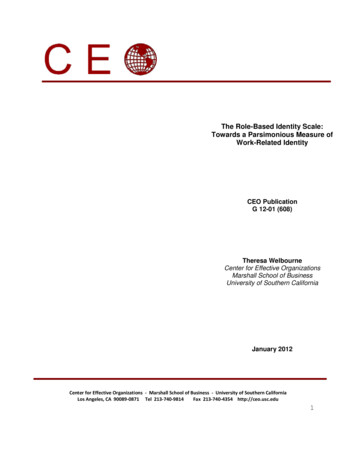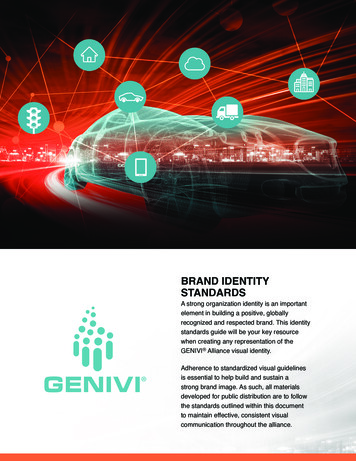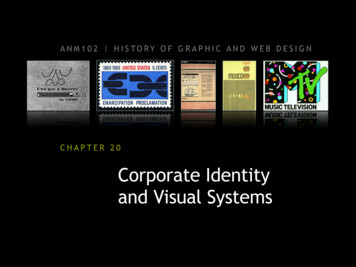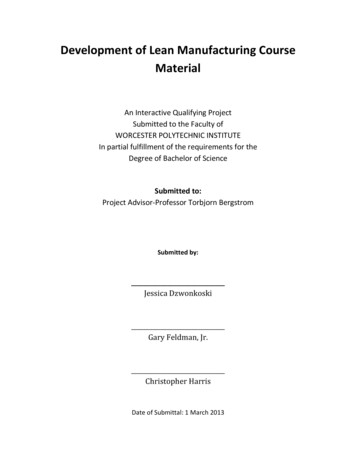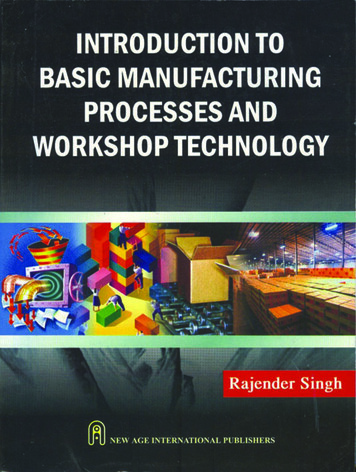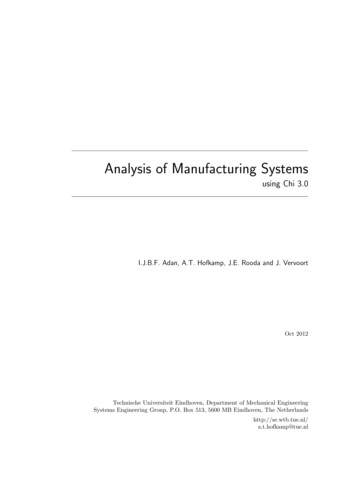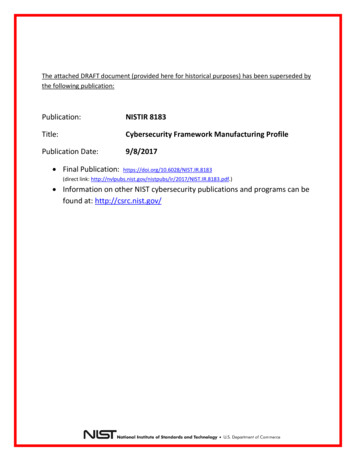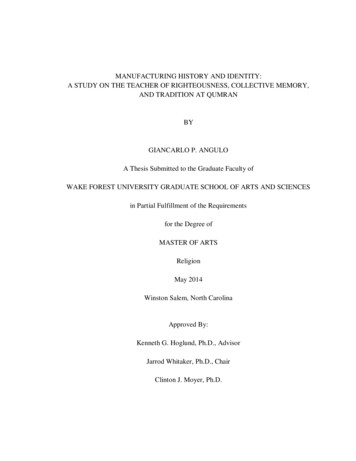
Transcription
MANUFACTURING HISTORY AND IDENTITY:A STUDY ON THE TEACHER OF RIGHTEOUSNESS, COLLECTIVE MEMORY,AND TRADITION AT QUMRANBYGIANCARLO P. ANGULOA Thesis Submitted to the Graduate Faculty ofWAKE FOREST UNIVERSITY GRADUATE SCHOOL OF ARTS AND SCIENCESin Partial Fulfillment of the Requirementsfor the Degree ofMASTER OF ARTSReligionMay 2014Winston Salem, North CarolinaApproved By:Kenneth G. Hoglund, Ph.D., AdvisorJarrod Whitaker, Ph.D., ChairClinton J. Moyer, Ph.D.
AcknowledgmentsIt would not be possible to adequately present the breadth of my gratitude in thescope of this short acknowledgment section. That being said, I would like to extend a fewthanks to some of those who have most influenced my academic and personalprogression during my time in academia. To begin, I would be remiss not to mention themany excellent professors and specifically Dr. Erik Larson at Florida InternationalUniversity. The Religious Studies department at my undergraduate university nurturedmy nascent fascination with religion and the Dead Sea Scrolls and launched me into thecareer I am now seeking to pursue. Furthermore, a thank you goes out to my readers Dr.Jarrod Whitaker and Dr. Clinton Moyer. You have both presented me with wonderfulopportunities during my time at Wake Forest University that have helped to develop meinto the student and speaker I am today. Your guidance and review of this thesis haveproven essential for me to produce my very best work. Also, a very special thank youmust go out to my advisor, professor, and friend, Dr. Ken Hoglund. Your patience,brilliance, and unwavering support have helped me reach heights I often did not thinkpossible. Our conversations have greatly improved this thesis as well as my ownprogression as a student and a colleague in the field of Religion. Finally, none of thiswould have been imaginable without the emotional support and encouragement of myfamily and friends. I thank you all so very much for putting me in a position to succeedand believing in me even when times were difficult.ii
Table of ContentsAbbreviations . ivAbstract . . vChapter One . . 1I.II.III.IV.The Dead Sea Scrolls and Collective Memory . . 8Historical Context . 17The Title מורה הצדק . . 23Conclusion 27Chapter Two . . 29I.II.III.IV.V.VI.VII.Teacher as Prophet 31Teacher as High Priest . 36Teacher as Founder . 41Teacher as Eschatological Figure. . 44Teacher as Suffering Servant . . 47Identifying the Teacher of Righteousness . 50Conclusion 56Chapter Three . . 59I.II.III.IV.Memory Distortion and Narrativization 60The Teacher Tradition and Biblical Leaders . 69The Teacher of Righteousness and the Ezra Model . . 77Conclusion 85Chapter Four . 87I.II.III.IV.The Prototypical Teacher . . 87The Imagined Teacher of Righteousness . . 90Synopsis 92Conclusion 97Bibliography . . 100Curriculum Vitae . . . 108iii
Abbreviations1QHHodayot1QpHabPesher Habakkuk1QpMicPesher Micah1QSRule of the Community4QpIsPesher Isaiah4QpNahPesher Nahum4QpPsPesher PsalmCDDamascus DocumentDSSDead Sea Scrollsiv
AbstractThe Dead Sea Scrolls corpus presents a leadership figure presiding over theQumran movement known only by the sobriquet “Teacher of Righteousness.” Thisshadowy character has garnered a significant amount of scholarly attention due to itsextraordinary role in the formation and maintenance of Qumran’s sectarian identity.Despite exhaustive efforts to better understand the group’s figurehead, the Teacher ofRighteousness has remained an obscurity with the only general consensus being that itrepresented an historical figure in the Second Temple period. This thesis seeks toproblematize this consensus and argue for an imagined leadership figure produced inorder to legitimize the sectarian movement. The argument is presented through thepurview of collective memory theory in order to read the historical recordings in theDead Sea Scrolls and the experiential narratives of the Teacher as a tradition rather thanobjective reality. Furthermore, this thesis looks to display substantial continuity betweenthe scrolls’ presentation of the Teacher of Righteousness and biblical heroes abound thememory of the Qumran sectarians. In arguing for a fictitious Teacher figure in the DeadSea Scrolls, this thesis seeks to discourage further research into the figure’s historicalpersona and rather encourage future inquiry to focus on the influence of its narratives onthe Qumran members.v
Chapter OneThe leadership figure in the Qumran movement known as מורה הצדק , the Teacherof Righteousness, constitutes the most mysterious and consequential character in theDead Sea Scrolls. The title appears in some form in at least seventeen occurrencesthroughout the Qumran corpus.1 Scribes display their leader in several variant wayswhich include: ;יורה הצדק ;מורה הצדקה ;מורה ;מורה צדק and the aforementioned definitiveform מורה הצדק .2 The person behind the title is portrayed in several different lightsthroughout the scrolls including, but not limited to, taking on the role of prophet, priest,and founder. Due to the high volume of appearances by the מורה הצדק throughout thewritings of the scrolls, the position he is portrayed to have employed, and the influence aleader may have had on a community of his exilic followers, there has been an abundanceof research done on the subject. He has, in fact, almost unanimously been considered thesingle most important character in the Dead Sea Scrolls corpus.3 Inquiry has normallyrevolved around three major issues: (1) what person known through other Second Templewritings is behind the epithet? (2) What can be reconstructed about the Teacher’s life andhow does this relate to the origins of the Qumran community? And (3) which documentsfrom the Dead Sea Scrolls, if any, were authored by the Teacher of Righteousness? 41Stuckenbruck (2010: 26-27) relays the following passages as specifically mentioning the Teacher ofRighteousness: 1QpHab 1:13; 2:2; 5:10; 7:4; 8:3; 9:9-10; 11:5; 1QpMic (1Q14) 10:6; 4QpPsa 4Q171 1-103:15, 19; 4:8, 27; 4QpPsb (4Q173) 1 4, 2 2; an unidentified pesher fragment (4Q172 7:1); CD A 1:11; 6:11.The use of this sobriquet in the variant forms provided appear in six further texts: CD B 20:1, 14; 4QpPs a 110 1:27; CD B 20:28; 4QpIsac (4Q163) 21:6; and depending on its restoration, 4QpIsae (4Q165) 1-2 36.2Based on the context there is no reason to believe that the different titles refer to separate people but ratherone individual or office. Rabinowitz (1958: 392-393) even notes that in one case a scribe seems to havecrossed out the first three letters of יורה and proceeds to fill in the word מורה . He concludes that the authorregarded the masculine singular participles qal and hiph’il from the root ירה as synonyms.3Stuckenbruck 2007: 784Stuckenbruck 2007: 75-761
Despite exhaustive efforts to understand this shadowy character, scholarship hasremained conflicted with theories ranging from the possible to the absurd.One of the more curious aspects involved in the study of the Teacher ofRighteousness is the fact that he was discovered in the Cairo Geniza well before the restof the Dead Sea Scrolls. Solomon Schechter first published the work which has come tobe known as the Damascus Document under the headline “Fragments of a Zadokite Work”in 1910. It is not known how the document made its way to Cairo or what bearing thathas on the Qumran movement but the important point for this study is Schechter’s earlywork on the Teacher of Righteousness. Beyond simply stating that the Teacher was anhistorical character, he further developed his theory to envelop the Messiahs of Aaronand Israel into the personage of the Teacher of Righteousness and he ascribed thecommunity’s founding to this person.5 Some modern scholars who study the figure of theTeacher of Righteousness have expressed questions about what the field would be likehad scholarship not previously been aware of the Teacher’s existence. Since Schechterfirst proposed the likelihood that the Teacher of Righteousness in the DamascusDocument was an historical character, most of scholarship has continued with this themeand looked to explore the identity of the Teacher. In fact, scholars often refer to hishistorical validity as the only consensus about the figure. 6 The Teacher’s historicity hasbeen accepted almost as a truism in Qumran scholarship and the few studies which havedemurred this position have failed to sway the field.56Schechter 1910: 44-45Wacholder 1999: 282
The purpose of the current project is two-fold. The history of scholarly discourseconcerning the Teacher’s role and historical character will be presented in order todemonstrate the widespread disagreement regarding the leader of the Qumran sect.Despite the fact that most consider him to be certainly an historical character the evidence,or lack thereof, has left conclusions varied and asserted. When considering the historicityof the Teacher of Righteousness and his historical counterpart it is simply the case thatthe evidence is lacking in the Dead Sea Scrolls to find any definitive conclusions. 7Moreover, the continuation of historical investigation into the nature of Qumran’s leadermay obfuscate the social significance of the Teacher’s narrative. While discussing theTeacher Hymns Hypothesis8 in the Hodayot, Newsom claims that the emphasis on thehistorical Teacher’s connection with the text has deleterious effects toward the greaterunderstanding of the influence that the scroll had on the community: “What tends to getleft to one side,” Newsom writes, “is how these Hodayot functioned over time, as theywere continually read or recited, to shape the ethos of the community and to addressperennial questions of sectarian life.”9 Similarly, I posit that the continued historicalinquiry into the Teacher of Righteousness fails to acknowledge how the narratives abouthim shaped the cosmological worldview of the community and raised the value of what itmeant to be a member in the Qumran movement.After presenting the ongoing discourse about the historical Teacher ofRighteousness and the complications involved, this work will attempt to problematize theone consensus that has been reached concerning the Qumranic figurehead. It is the thesis7Wise 2003: 87The Teacher Hymns Hypothesis constitutes the proposed reading of portions of the Hodayot, particularlycolumns X-XVII, as having been authored by the historical Teacher of Righteousness. For more about thistheory and its rebuttal, see pg. 4 n. 10.9Newsom 2004: 28883
of this project that the mysterious appearance and death of the Teacher in the DamascusDocument, the lack of his direct authorship of Qumran texts, and his absence fromhistorical descriptions of the Essene community recounted by Josephus and others can beexplained if one views this figure as a literary character formed by the community toserve social purposes from a memory of biblical leaders. 10 In raising this point I hope todiscourage the study of the Teacher of Righteousness’s historical personage and ratherencourage future research to examine the impact the figure’s narrative had on thecommunity of his followers.It is unreasonable, however, for this study or any other to suggest that the authorsof the Dead Sea Scrolls invented the Teacher of Righteousness out of thin air to serve anunheralded position or function. Such a stance will not be taken in the argument of thispaper. The Teacher employs a position well recognized in offshoot groups for a very longtime. He takes up the place of charismatic leadership described by Max Weber. Weberclaims that in communal organizations there seems to be one person who is regarded byhis followers as endowed with charismatic authority and who takes a position ofleadership. Charisma, as defined by Weber, is “a certain quality of an individual10I will be operating under the recently advanced theory that the Teacher of Righteousness did not authorthe famously known “Teacher Hymns” in the Hodayot. The theory that proposes the first-person accountfound in the Hodayot as expressed by the historical Teacher of Righteousness is widely known as theTeacher Hymns Hypothesis and is credited to the German Heidelberg School from the 1960’s. Their worksought to prove the long-held assumption proposed initially by Eleazar Sukenik (1955). However, Harkinshas recently revisited this hypothesis and concluded that it relies on false and romantic ideas aboutauthorship and ignorance of manuscript evidence. She writes, “Scholars who were impressed by the strongand distinctive literary style, which I will refer to as the strong ‘I’ of the TH, went on to draw conclusionsthat, in my view, the texts do not warrant by claiming that the hodayot in X-XVII give evidence of anactual historical person’s experiences of distress and deliverance.” (Harkins 2012: 20) Newsom (2004: 288)similarly expresses doubt about the Teacher Hymns Hypothesis. She proposes that the “I” in the Hodayotmay refer to the Mebaqqer or function as a way to articulate a leadership myth that was appropriated by thecurrent Qumran leader. Other studies which question this theory include Michael O. Wise, The FirstMessiah: Investigating the Savior before Jesus (New York: Harper Collins, 1999) and Israel Knohl, TheMessiah Before Jesus: The Suffering Servant of the Dead Sea Scrolls (trans. David Maisel; Berkeley:University of California Press, 2000).4
personality by virtue of which he is set apart from ordinary men and treated as endowedwith supernatural, superhuman, or at least specifically exceptional powers or qualities.” 11The endowed qualities of the Teacher of Righteousness display striking similarities toother exemplary biblical leaders such as Moses. Based on the presence of biblicaldocuments among the Qumran scrolls it is easily deduced that the community is wellaware of the Hebrew Bible and its narratives of righteous groups of the past. 12 Thestructure and roles of characters such as Moses and Ezra would have been deeplyingrained in the minds of exilic people on the path to living justly in the eyes of theirsupreme God. That being said, this paper will present the positions of biblical figures asboth leaders and prophets and hold them in direct comparison to the portrayal of theTeacher of Righteousness in the Qumran writings. By highlighting a significant numberof similarities between the Teacher and the authors’ memory of biblical heroes it will beargued that the Teacher of Righteousness was constructed based on the position he wasprojected to fulfill.The proposition of a false Teacher in the Dead Sea Scrolls comes on the heels ofother scholarly inquiry into the historicity of prophetic figures such as Malachi. Manyscholars suspect that the prophet never really existed and was used either as an epithet or11Weber 1947: 358The problem of using the terms Hebrew Bible and canon for Second Temple times has long beenrecognized. For an overview of the Bible’s progression and authority in the time of the Qumran communitysee Jonathan G. Campbell, “’Rewritten Bible’ and ‘Parabiblical Texts’: A Terminological and IdeologicalCritique” in New Directions in Qumran Studies (ed. by Jonathan G. Campbell, William John Lyons &Lloyd K. Pietersen; London: T & T Clark International, 2005); Shani Tzoref, “Qumran Pesharim and thePentateuch: Explicit Citation, Overt Typologies, and Implicit Interpretive Traditions” in Dead SeaDiscoveries 16 (2009), 192. In order to avoid being pedantic in this work I will refer to the presentlyrecognized biblical texts and the primary texts cited in the pesharim (Habakkuk, Psalms, and Micah) asHebrew Bible on the basis of the community’s recognition of these writings as authoritative, as evident bytheir insistence on assimilating the scriptures into their community.125
merely constituted the title of the book.13 Scholarship has found it impossible todefinitively prove anything concerning the prophet Malachi. The name does not appearelsewhere in the Hebrew Bible as a proper noun and literally translates to “mymessenger.” According to Redditt, many have deemed such a name inappropriate for aparent to possibly give to a child. They conclude, then, that the name was a shorter formof something like Malachijah which would result in either the blasphemous translation“God is my messenger” or “Messenger of God.” Redditt finds this argument difficult inits assertion and concludes Malachi to be a title taken from Mal. 3:1 where the word isonce again used. 14 Moreover, there is absolutely no historical information provided aboutthe prophet in the book of Malachi or elsewhere. He seems to only appear for the purposeof authoring this work and then proceeds to vanish from the record books. Whatever thecase may be, the historical personage of the prophet Malachi has garnered a substantialamount of doubt in biblical scholarship.The scholarly investigations and suspicions regarding the historicity of theprophet Malachi for these reasons provide significant parallels with the proposed studyon the Teacher of Righteousness. If what many scholars assume is correct and Malachifunctions as a title rather than a proper name then there is an obvious comparison to theTeacher in the scrolls. It has long been the purpose of Qumran scholarship to discern thehistorical name of the Teacher of Righteousness. This title is seen nowhere else soprominently other than in the Dead Sea Scrolls writings and is not mentioned by anySecond Temple historians such as Josephus. The Qumran leader figure is presented only1314Sweeney 2005: 207 & Lundbom 2010: 134Redditt 2008: 1516
by his sobriquet which is clearly meant to perpetuate a position on high. 15 This is analmost identical situation to what was discussed regarding Malachi. Furthermore, likewith the prophet Malachi, there is no direct reference to the Teacher’s historical life suchas a genealogy or hometown. In fact, even his appearance into the community (CD 1:9-11)and his abrupt death (CD 20:1) depicted in the Damascus Document are clouded inallusions.As I have noted above, there has been a tremendous amount of work on the figureof the Teacher of Righteousness in the scrolls. So why is it important for there to beanother study on the figure and, more specifically, why is it important to have thisparticular project on the Teacher? The result of a prophet-like leader for the Qumran sectis paramount to their communal identity and their members’ ability to avoid cognitivedissonance regarding their new metaphysical beliefs in tension with their perception ofthe corrupt social landscape of Second Temple Jerusalem. 16 The narratives about theTeacher of Righteousness depicted in the Dead Sea Scrolls that project him as sent byGod (CD 1:10-11), a divine recipient of revelation (1QpHab 7:4-5), and the founder of achosen community (4QpPsa 3:15-16) functioned not only to create an appropriate leaderreminiscent of Moses but to inculcate the Qumran members with the belief that they areGod’s righteous elect. Stories people read and tell to each other are the driving force thatcreates and sustains communal identity and worldviews.17 A set understanding whichinvolved a prophet-like messenger sent by God for the purpose of raising you, a righteous15Jokiranta (2013: 178) writes that “the teacher’s title claims that he was sent by God, to give the people afresh start, and to assist it in its search for justice.”16My categorization of the Qumran community as a sectarian movement is informed by Jokiranta’s (2013:17-76) discussion on the matter. Jokiranta (2013: 50) concludes that the Qumran movement should bedubbed sectarian by using Stark and Bainbridge’s definition which claims one to be “a deviant religiousorganization with traditional beliefs and practices.”17Smith 2003: 63-947
community, would have resulted in great reassurance for the group of exiles who lefttheir worlds behind in Jerusalem. Therefore, what is crucial for the development ofQumran life is the narrative about the Teacher of Righteousness as presiding over thecommunity and not so much the actual historical figure. The Teacher, in this case,constitutes a figure of memory which contains the community’s identity, validation, andauthority to construct new laws and interpretations.18 Scholarship’s assertion that theTeacher of Righteousness must be an historical person and their focus on characters fromthe time period is remiss of the real influence of the figurehead in the Qumran sectarian’slife. For the community to have believed in a prophetic leader as having at some timereigned over their movement is as substantial as there ever having been an actualhistorical actor.The Dead Sea Scrolls and Collective Memory TheoryBefore delving into the study of the Teacher of Righteousness there must be someconsideration for the methodology to be utilized in this project. It would be impossible toargue for a fictitious Teacher in the scrolls if one takes the content of the Qumranwritings to be literal. Therefore, this paper is inclined to read the Dead Sea Scrolls as notthe storage of facts per se but the passing down of a memory that would inscribe theindividual members who make up the collective whole with a belief that they are therighteous of God and enjoy a superior status to their cultural counterparts. It has longbeen recognized that the Babylonian exile of 587/586 BCE had a lasting influence on the18Figures of memory are defined by Assman (1995:129) as “fateful events of the past, whose memory ismaintained through cultural formation (texts, rites, monuments) and institutional communication (recitation,practice, observance).”8
writings of the prophets.19 Authors struggled to present a world in which YHWH reignedsupreme and just amidst a reality in which those considered to be righteous had beenattacked. The Qumran community similarly believed itself also to have gone through anexile. Brooke writes,The movement that the Teacher brings into focus rewrites the notion ofexile present in the Deuteronomistic History by insisting that the SinExile-Return model is to be applied to Israel’s experiences in a way ratherdifferent than the reformed returnees of the late sixth and fifth centuriesB.C.E. might have supposed.20The Qumran authors clearly felt that Jerusalem and its people had gone astray and itproceeded to live separated from Jerusalem because of this. 21 Similar to the post-exilicprophetic authors, the scribes of the Dead Sea Scrolls would have grappled with the needto present a justification for their exile and assure God’s steadfast remainder with them. 22Just as the prophetic writings were meant to instill a certain behavior and worldview intoits readers, so to the Dead Sea Scrolls were meant to reassure the group members of theirplace in God’s plan and their correctness to have left their world behind.The issue of memory and its dependability to recount an accurate portrayal of anexperiential past has become a problematic matter in recent social inquiry. Memory itselfhas been recognized to constitute a highly fallible phenomenon which is embedded in andinfluenced by many of the reminiscing party’s social circumstances. The production of19Sweeney 2005: 15. Sweeney states that the prophetic writings of the Hebrew Bible provide some of themost profound theological questions about evil vs. righteousness as they try to come to grips with theBabylonian destruction of Jerusalem and the Temple as well as the concept of restoration after theexperience of the exile.20Brooke 2010: 5121VanderKam 2002: 275-292. VanderKam reviews the way in which several groups from the SecondTemple period (Pharisees, Sadducees, etc.) are referred to in the Qumran scrolls. These labels, such as the“seekers of smooth things/easy interpretations,” often carry a pejorative connotation.22Collins (2011: 306), for example, writes that the “pesharim are written to assure the faithful that theirvindication is guaranteed by prophecy, and that prophecy is being fulfilled in their time.”9
history is at its core merely the recollection and subsequent codification of a memory –either personal or collective – concerning past events. This process of recollection,however, can no longer be considered an innocent nor objective practice. 23 Instead, recentdevelopments in the field of memory have come to recognize the many complex factorsthat influence and shape the presentation of past experiences. That is to say that theproduction and perpetuation of a memory is seen as a strategic maneuver with expectedrepercussions in the present era. The transmission of a particular perception of the pastworks in a cyclical fashion in that it is both produced with an eye to serve the present andthe present similarly – and often times subconsciously – shapes one’s memory of thepast.24The transmutation of memories is largely a function of its own self-interest. Inother words, particular presentations of the past with specific rhetoric, events, andconnotations, are advanced in order to push one’s agenda.25 Memories thus remainmalleable in order so that they may be recalled, reinterpreted, and revised to suit evolving23Allison 2010: 1; Burke 1989: 98The proposition that several factors revolving the time of the composition of a memory inevitably alterthe structure of a given memory is regularly referred to as ‘memory distortion.’ For instance, the timeelapsed between the historical event and its recording will undoubtedly cause the memory of theaforementioned event to become rather vague and specific details may be forgotten only to be replaced bynewly developed scenarios or interpretations (Schudson 1995: 348-360). As Allison (2010: 2) states, “Torecollect is not to play back a tape. Memory, at least long-term memory, is reconstructive as well asreproductive and so involves imagination.” Also, the specific reason for sharing a memory as well as theaudience for which it is presented will significantly alter the proposal of a single past event. In this case,Engel (1999: 12) provides a wonderful description of how these social factors contribute to the formationof a past memory: “Think back to some charged event in your own life. Perhaps the first fight you had withyour spouse. Now imagine telling that story to your mate, many years later at the celebration of yourtwenty-fifth wedding anniversary, telling it to the divorce lawyer, telling it to your children now that theyare grown up, writing it in a humorous memoir of your now famous life, or telling it to your therapist. Ineach case the person you are telling it to, and the reasons you are telling it, will have a formative effect onthe memory itself.”25The re-presentation and transmission of memories are a part of “our continued efforts to make coherenceof our own lives, to synthesize past and present so as to face the future.” (Rose 1998: 429-454)2410
demands.26 This is true at both the individual and the collective level. In this respect,memory undoes itself from the stigma of objectivity and instead must be viewed as amore strategic means of projecting history. As Megill elaborates,On the one hand, ‘history’ appears as a pseudo-objective discourse thatrides roughshod over particular memories and identities, which claim tohave an experiential reality and authenticity that history lacks. On theother hand, memory appears as an unmeasured discourse that, in theservice of desire, makes claims for its own validity that cannot bejustified.27In similar fashion Assman proclaims,Seen as an individual and as a social capacity, memory is not simply thestorage of past “facts” but the ongoing work of reconstructive imagination.In other words, the past cannot be stored but always has to be “processed”and mediated. This mediation depends on the semantic frames and needsof a given individual or society within a given present. 28The declaration of a particular memory as representative of an individual or communityis invariably selective.29 A community perpetuates a specific memory of the past becauseit is what proves most conducive to the desired results for the needs of the present. At thesame time, however, other memories and representations are pushed into darkness andsubsequently forgotten.Inquiry into the dynamics of memory in the collective sphere is a subject that hasgained steam in biblical and historical discourse over the past twenty years. 30 The26Olick & Robbins 1998: 128Megill 1998: 3828Assman 1997: 1429Schudson 1995: 34830Olick & Robbins reference Schwartz (1996) as identifying three related aspects of 1960s-1970sintellectual culture that contributed to the emergence of interest in the social construction of the past. Hewrites, “First, multiculturalists identify historiography as a source of cultural domination and challengedominant historical narratives in the name of repressed groups. Second, post-modernists attack theconceptual underpinnings of linear historicity, truth, and power. Finally, hegemony theorists provide a2711
systematic theory of collective memory31 is normally credited to have been introducedinto the social sciences first by the French scholar Maurice Halbwachs in his seminalwork The Social Frameworks of Memory (Les cadres sociaux de la mémoire).32 ForHalbwachs, memory is determined by an already well-established collective or individualidentity. He claims that a meaningful identity, which has already been assumed by acommunity, goes about creating itself a past which is c
Dead Sea Scrolls and the experiential narratives of the Teacher as a tradition rather than objective reality. Furthermore, this thesis looks to display substantial continuity between the scrolls' presentation of the Teacher of Righteousness and biblical heroes abound the memory of the Qumran sectarians.
